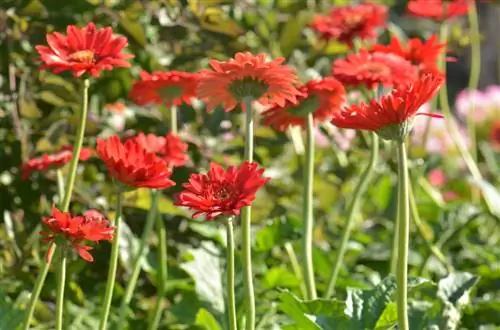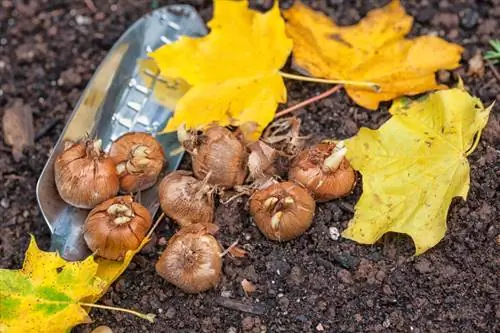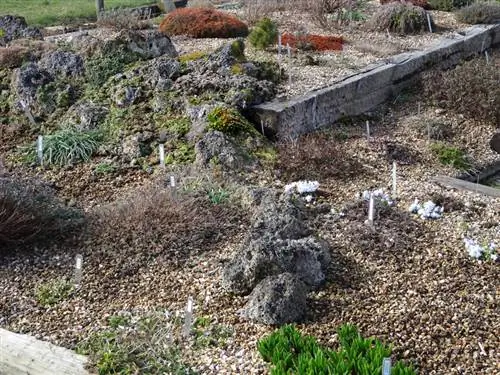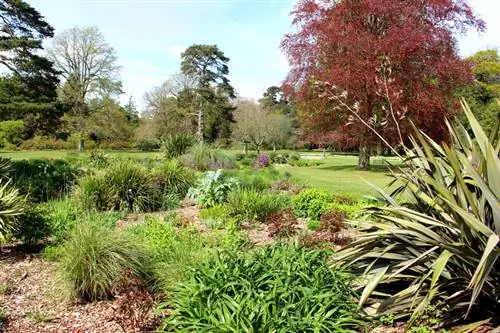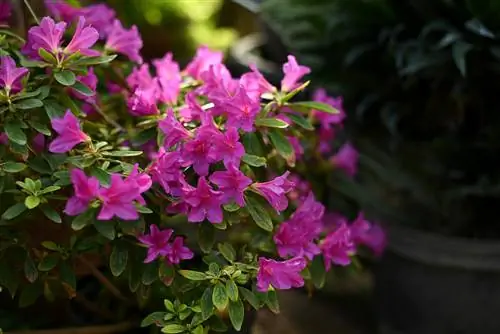- Author admin [email protected].
- Public 2023-12-25 17:45.
- Last modified 2025-01-23 11:21.
Azaleas take our breath away with their lavish blooms and at the same time challenge our skills as hobby gardeners. If you come across a horticultural stumbling block during cultivation, don't spend long with uncertainty. Frequently asked questions are answered here in a compact and practical manner.

How to care for an azalea in the garden?
Azaleas need a location with a sunny to partially shaded location, acidic soil (pH value between 4.0 and 5.5) and good air circulation. Your care includes constant moisture, regular fertilizing and removing spent flowers. Light winter protection is recommended in rougher locations.
Planting azalea correctly
So that the dream of a paradisiacally flourishing azalea in the garden comes true, lay the foundation with skillful planting. First check the pH value at the chosen location, as it should be between 4.0 and 5.5. Ideally, the location is sunny to partially shaded and offers humus-rich, deep soil. This is how the procedure works successfully:
- Dig a planting hole 30-50 cm deep and four times the diameter of the root ball
- Optimize the excavation with leaf compost, ericaceous soil and horn shavings
- Plant the azalea while maintaining the previous planting depth and water with soft water
When planting in a pot, add a few pottery shards (€4.00 on Amazon) between the substrate and the floor opening as drainage.
Care tips
By choosing the right location, you are halfway to successfully cultivating azaleas. How to care for the rose tree with expertise:
- Keep the substrate constantly moist with soft water
- Fertilize organically or minerally every 4 weeks from April to September
- Clean up wilted flowers regularly
- Cut back if necessary at the end of the flowering period
- Light winter protection in the year of planting and in rough locations is recommended
If the rose tree becomes bare from the inside over the years, give it a rejuvenation cut in early spring. Otherwise, pruning measures on this ornamental tree play a minor role.
Which location is suitable?
For a garden azalea to live up to its middle name, rose tree, the light and temperature conditions should be as follows:
- Sunny to partially shaded location, with protection from the blazing midday sun
- Airy and cool, without summer heat
- Nutritious, fresh, moist and acidic soil with a pH value of 4.0 to 5.5
The wetter the soil, the sunnier the location can be. The small flowering tree finds optimal living conditions when it is located under the protection of tall deciduous and coniferous trees.
The correct planting distance
The expected growth height of an azalea defines the planting distance within a group. The following values have proven themselves very well in practice:
- Slow-growing species, such as Japanese azaleas: 30-50 cm
- Deciduous hybrids, such as Knapp Hill azaleas: 50-80 cm
- Strong-growing varieties, such as Ghent azaleas: 80-100 cm
The planting distance is measured at crown height from tree to tree.
What soil does the plant need?
In their natural range, azaleas thrive in the loose, humus-rich forest soil of Southeast Asia, which is constantly moist due to frequent rainfall. The closer the conditions in the garden come to these criteria, the more vitally the opulent flowering tree will thrive. The following characteristics are important:
- Loose, fresh-moist and rich in nutrients
- An acidic pH value of 4.0 to a maximum of 5.5
- No risk of waterlogging
In order for an azalea to thrive in a planter, we recommend using a special rhododendron soil with an appropriately acidic pH value.
What is the best time to plant?
The ideal time window to plant an azalea opens twice a year. The best time is from early September to mid-November. Alternatively, plant the rose tree in the weeks between mid-March and the end of May.
When is flowering time?
In the garden, the azaleas bloom in April when the weather is normal. The magnificent tree boasts its white, red or purple flowers until August/September. If you can't get enough of this enchanting abundance of colors, cultivate an indoor azalea on your windowsill at home throughout the winter. Their flowering period extends from October to April.
Cut azalea correctly
At the end of the flowering period, cut off the withered azalea flowers so that the rose tree does not invest all of its energy in growing seeds. There is nothing wrong with taking this opportunity to shorten the ornamental tree to the desired size and thin it out thoroughly. A topiary also encourages the plant to branch out extensively, creating a bushy and compact silhouette. An overcast, mild day in March can be considered as an alternative date for cutting, as the leafless state provides a better view of the overall appearance.read more
Watering azalea
Water an azalea regularly with soft, lime-free water. The substrate should not dry out at any time, even in winter. Ideally, you should check the moisture content of the soil during your daily walk around the garden so that you can water if necessary. The rose tree thanks you for a gentle spray in the early morning or in the evening with fragrant clouds of flowers over lush green foliage.
Fertilize azalea properly
In March, start fertilizing to get growth going. Choose organic fertilizer, such as acidic leaf or needle compost with horn shavings. Until October, apply compost or an alternative organic fertilizer every two weeks. Alternatively, apply a mineral rhododendron fertilizer with immediate effect in March and then continue the nutrient supply on an organic basis.
Wintering
Since garden azaleas are deciduous ornamental trees and are also completely hardy, well-established specimens do not require extensive winter protection. Only in the year of planting and in rough locations do we recommend the following precautions:
- In autumn, cover the tree slice with leaves and pine needles
- Wrap the crown of the freshly planted tree with jute ribbons or fleece
- Water the azalea in clear frost on a mild winter day
Wrap a bucket with several layers of bubble wrap and place it on a block of wood. It is best to cover the substrate with peat or wood wool.
Propagate Azalea
You can choose from the following methods for propagating azaleas:
- Pull the sinker to the ground, bury in the middle and maintain until a root system has developed
- In summer, cut cuttings 15 cm long, place in small pots, put on a hood and keep moist
The lowering method has the advantage that the mother plant continues to supply the offspring while it is rooting. The cutting method scores points with the possibility of growing the young azalea on the windowsill throughout the winter in order to plant it out in spring.
How do I transplant correctly?
The best time to transplant a rose tree is in autumn. At this time the azalea roots more quickly in the sun-warmed soil. In contrast to other ornamental trees, there is no pruning in connection with a change of location. This requirement applies to all rhododendron species, not just azaleas.
Azalea in pot
As a small tree or shrub, the azalea decorates the summer balcony with its lavish flowers when it can extend its roots in acidic rhododendron soil. Drainage over the water outlet in the bottom of the pot prevents harmful waterlogging. Since there is always a higher water requirement in the pot, daily thumb testing is the gardener's top priority. If the soil feels dry, water with soft water. In terms of nutrient supply, care runs in a regulated manner if you administer a liquid azalea fertilizer according to the dosage instructions. If you protect the pretty flowering tree from the blazing midday sun and pamper it every day with a lime-free spray mist, the gem will attract everyone's attention.
Is azalea poisonous?
As a member of the heather plant family, toxic substances flow through the supply pathways of an azalea. Consuming flowers and leaves can cause significant symptoms of poisoning, so small children and pets should not come near the rhododendron. So that you don't have to deal with unpleasant skin irritations, we recommend wearing gloves for all planting and care work.
Yellow leaves
If the leaves turn yellow well before the start of autumn, the azalea is suffering from leaf chlorosis. This damage results from using hard tap water. If you immediately switch the water supply to lime-free water, the tree will recover.
How do I care for an indoor azalea?
For an azalea to bloom on the windowsill from October to spring, a sunny to semi-shady location is important, with cool temperatures not exceeding 18-20 degrees Celsius. In addition, a high humidity of 60-70 percent is the top priority. A spot on the west or east window is ideal, as is the south window, as long as there is protection from the blazing midday sun. If these site conditions are met, maintenance is quite straightforward:
- Watere regularly with lime-free water so that the soil never dries out
- Spray every 1-2 days with soft, lukewarm water
- Fertilize liquidly with a special preparation for rhododendrons in a highly diluted concentration
- Clean out wilted flowers every few days to encourage new growth
At the end of the flowering period, cut off all withered flower heads and shorten shoots that are too long to the desired length. The flower beauty spends the summer in a partially shaded spot in the open air.
What are the differences between rhododendron and azalea?
Within the genus Rhododendron, different species and varieties are called azalea. Although there is still disagreement among experts regarding the exact systematization, the following rule has become established among gardeners: Azaleas are summer and winter green types of rhododendrons that primarily come from Japan. In addition, the non-hardy, evergreen rhododendron species from India are defined as indoor azaleas because they are ideal for cultivation in flower pots.read more
Beautiful varieties
- Cabaret: A fantastically beautiful, evergreen azalea with purple pink flowers in July and August; Growth height 130 cm
- Arista: Summer green variety with semi-double flowers in pink, underlined with delicate orange; Growth height 120-160 cm
- Petticoat: Impresses with bulging pink flowers and dramatic autumn colors; Growth height 60-70 cm
- Sarina: Premium variety with salmon pink flowers and wonderful autumn colors, robust and hardy; Growth height up to 140 cm
- Goyet: Indian indoor azalea with dark red, ruffled flowers, blooming profusely; Growth height 50-70 cm
- Gold Topaz: Historic Knapp-Hill Azalea with yellow flowers from May to June and robust winter hardiness; Growth height 120 cm
- Ice Princess: Dwarf variety with lush, double flowers in pure white; ideal for pots with a growth height of up to 35 cm


